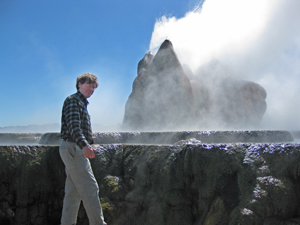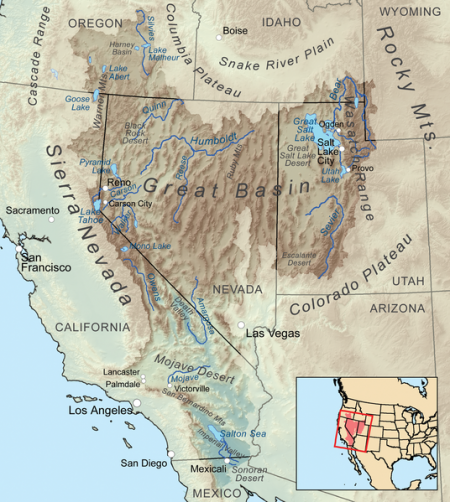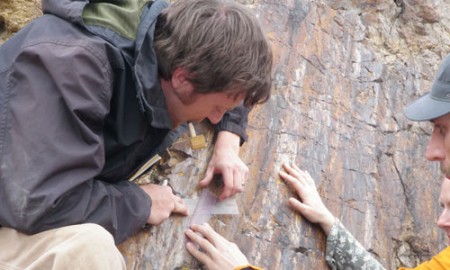Jul
11
Building Step One for Major Geothermal Growth
July 11, 2011 | 2 Comments
University of Nevada’s Bureau of Mines and Geology in the College of Science funded by a $1 million Department of Energy grant from the American Recovery and Reinvestment Act of 2009 has reached the one-year mark. The money is being spent to understand and characterize geothermal potential at nearly 500 sites throughout the Great Basin – of which Nevada occupies a major part.
The research aim is to provide a catalogue of favorable structural elements, such as the pattern of faulting and models for geothermal systems and site-specific targeting using innovative techniques for fault analysis. The project will enhance exploration methodologies and reduce the risk of drilling nonproductive wells.
Jim Faulds, geologist and research professor at the University of Nevada, who is principal investigator for the project, explains, “The geothermal industry doesn’t have the same depth of knowledge for geothermal exploration as the mineral and oil industries. Mineral and oil companies conducted extensive research years ago that helps them to characterize favorable settings and determine where to drill. With geothermal, it’s studies like this that will enhance understanding of what controls hot fluids in the earth’s crust and thus provide an exploration basis for industry to use in discovering and developing resources.”

Professor Faulds at the Fly Geyser lectures his geothermal exploration class at the Fly Ranch Geyser north of Gerlach, Nevada.
This is the basic stuff needed to learn about how to find and exploit the resources below.
Faulds has a team of six researchers and several graduate students working with him on various aspects of the project. Understanding the character of known geothermal systems is critical for new discoveries, targeting drilling sites and development. The success of modeling sites for exploration is limited without basic knowledge of which fault and fracture patterns, stress conditions, and stratigraphic intervals are most conducive to hosting geothermal reservoirs.
Faulds describes the situation, “Of the 463 geothermal sites to study, we’ve studied and characterized more than 250 in the past year, either using existing records or on-site analyses. We’ll continue to study more of the sites so we can develop better methods and tools for geothermal exploration. Most, about two-thirds, of the geothermal resources in the Great Basin are blind – that is, there are no surface expressions, such as hot springs, to indicate what’s perhaps 1,500 feet below the surface.”
Faulds and his team has reached the one-year mark and is entering phase two, when five or six of the 250 identified potentially viable geothermal sites will be studied in more detail. Some of the studied sites will even have 3-D imaging to help those in the industry better understand geothermal processes and identify where to drill for the hot fluids.
If the research works out reliably in the real world the benefits could be significant. Without exposed hot water at the surface like geysers, knowing what’s below has been, essentially a guessing game, replacing that with solid scientific principles should reduce the upfront risks.
Faulds and his team have defined a spectrum of favorable structural settings for geothermal systems in the Great Basin and completed a preliminary catalogue that interprets the structural setting of most its geothermal systems. Faulds points out, “This is the first attempt to broadly characterize and catalogue Great Basin geothermal systems in this way.”
“We want to help the industry achieve acceptable levels of site-selection risk ahead of expensive drilling,” Faulds said. “This study costs only $1 million, but it could cost a company several million dollars for drilling at a single prospect in the hopes that they hit a good hot well. Our research will provide the baseline studies that are absolutely needed if Nevada is going to become the Saudi Arabia of geothermal.”
The Great Basin can be a major resource. The University of Nevada at Reno runs the new National Geothermal Academy, the first such academy of its kind in the nation. The academy, which runs from June 20 through Aug. 12, offers a unique blend of geothermal-related classes.
The Academy is a consortium of top geothermal schools from around the country that have joined with the University of Nevada, including Cornell University, Stanford University, Southern Methodist University, West Virginia University, the Oregon Institute of Technology, the University of Utah and Dartmouth. The consortium is designed to transform and grow the national energy infrastructure to utilize America’s vast geothermal resource base. The academy will educate and train the next generation of scientists, engineers, plant operators and policymakers.
The enthusiasm is gaining ground and some rather good apostles. One example is Paul Schwering, a geophysics graduate student at the University of Nevada, and the student ambassador for the National Geothermal Academy.
According to Schwering, Nevada has an uncommonly high amount of geothermal energy available, energy waiting to be tapped into. Nevada’s geothermal reservoirs offer a continuous source of energy that is sustainable, clean, and free from radiation and doesn’t require burning fossil fuels. The end result presents tantalizing possibilities for Nevada.
“Nevada should be an energy exporter,” Schwering said. “And geothermal should be a big part of that – and we’ve got geothermal in spades.”
The Great Basin covers most of Nevada and notable parts of Oregon, Utah and California. With the potential electrical demand market, and California’s mystifying policies, there should be a great future for the other states to exploit an inexhaustible resource for everyone’s benefit. The know how gained will get beyond the Great Basin, too.
Comments
2 Comments so far




What I don’t understand is why geothermal companies have not focused their energy and capital in places like Kenya. The electricity price in these developing countries is significantly higher, therefore justifying the use of geothermal energy. Kenya is already investing in geothermal but using some of the most advanced latest technologies would make these projects even more viable, and higher returns for the investors.
[…] Building Step One for Major Geothermal GrowthJim Faulds, geologist and research professor at the University of Nevada, … Leave a comment « Studds shirts Comments are closed. […]